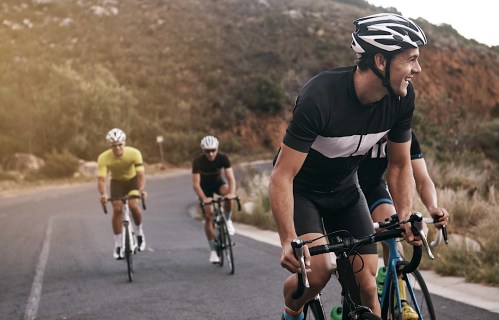‘This Is How My Approach to Working Out Changed After Becoming an Exercise Physiologist’
An avid cyclist shares how his workout approach changed after becoming an exercise physiologist and learning how to properly exercise.

Like a lot of people in their 20s and 30s, Scott Silveira’s approach to exercise could be summarized as: Go hard, or go home. “For instance, I used to think that if I just went out and rode my bike really hard, made every ride a hard ride, I would get better,” he says. “I think there was some truth to that—you have to prove [you can do it] to a degree. But I spent a lot of time just overtraining myself, so much so that it actually would negatively impact my performance because I was too tired to perform well.” He admits now that he didn’t really know how to properly exercise.
Experts in This Article
At the time, Silveira was a personal trainer, but he didn’t do the workouts he was giving his clients. “I would only ride my bike,” he says. “I would never do any resistance training. In fact, I thought that that might bulk me up too much and negatively impact my cycling.”
While his goal was to become a better cyclist, Silveira says he didn’t have any clear plan for how to go about it. “I would do a lot of just trial and error,” he says. “I would take what I thought were expert opinions for granted, and just kind of hope that whatever I did would work.”
That all changed though about seven years ago when Silveira went back to school to become a registered clinical exercise physiologist. (He now works at the Center for Health & Wellbeing at the Four Seasons Hotel Westlake Village in California.) Once he learned more of the science behind how our bodies respond to movement, his approach to working out significantly shifted. Here’s how.
1. He now cross-trains
Gone are the days when cycling was Silveira’s only workout. “I have more variety in my exercise plan,” he says. That now includes strength training, which Silveira has since come to realize only helps improve his cycling performance. “I like foundational moves like deadlifts, reverse lunges, incorporating things where I’ll do in internal and external shoulder rotation or even rows to help protect my shoulders and maintain good back posture,” he says.
2. He balances hard days with easy ones
He also makes sure to vary the intensity of his workouts now, so that there are highs and lows (something that’s better for brain health, BTW). “I pepper in really-high intensity workouts strategically—I don’t give ’em to myself all the time,” he says. “I might only do like one or two a week.”
3. He’s more intentional with his movements
“My exercise selections are a whole lot more deliberate nowadays than they used to be,” Silveira says. “I used to never think about how an exercise performed in a certain way might affect things like my rotator cuffs or my hips, or how it might affect the aging of my joints. And now I do consider those factors and I make sure that I’m doing things in a certain way so that I’m not predisposing myself to injuries that are gonna cost me later on.”
4. He prioritizes recovery
Prior to becoming an exercise physiologist, Silveira’s hardcore training schedule didn’t leave much time for rest days, which is how he wound up overtraining and ultimately undermining his goals to become a better cyclist. “I also don’t think I paid as much attention to things like how sleep would contribute to my recovery,” he says. “I didn’t pay so much attention to my diet—I would just eat whatever I wanted and thought, ‘Oh, okay, you know, I’ve performed pretty well, it must not matter.’”
Nowadays, Silveira takes time between workouts to let his muscles repair—and that includes getting quality sleep and adequate nutrition to support his system. “In general, I just try to get as many servings of vegetables in my diet as possible,” he says, adding that he also makes sure he’s getting enough protein for muscle maintenance, but is mindful not to overdo it. “I also definitely cut back a lot on processed foods.”
As a result of these tweaks to his training, Silveira says he’s fitter, faster, and stronger today than he was 15 years ago. “I’m actually pretty darn surprised,” he says. “I’m 42, about to be 43 in a bit, and it’s kind of amazing that I perform at just about the same level—if in some ways not better—than when I was younger.”
Sign Up for Our Daily Newsletter
Get all the latest in wellness, trends, food, fitness, beauty, and more delivered right to your inbox.
Got it, you've been added to our email list.










